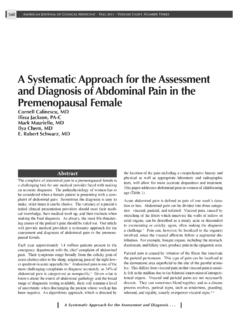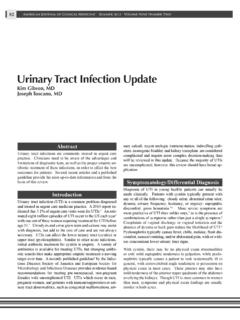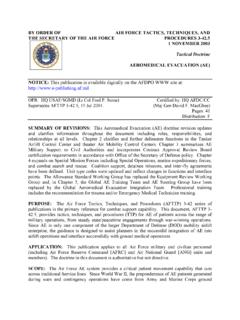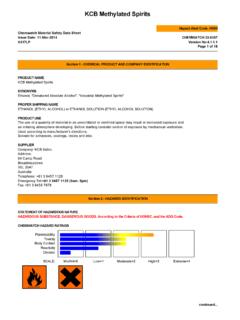Transcription of United States Air Force Aeromedical Evacuation – A ...
1 American Journal of Clinical Medicine Fall 2011 Volume Eight, Number Three153 AbstractThe use of United States Air Force (USAF) aircraft and person-nel to move wartime casualties is well established. This asset is also an integral part of the National Disaster Medical System (NDMS). The Aeromedical Evacuation (A/E) system, a part of Air Mobility Command, is a highly disciplined function capa-ble of transporting thousands of civilian casualties at all levels of criticality. At the time of a large local or regional disaster, civilian medical treatment facilities, if still functional, would be overwhelmed.
2 A core function of the NDMS would be the relocation of civilians currently hospitalized or in need of hos-pitalization to facilities outside the disaster area. This would be primarily accomplished by the USAF A/E United States Air Force (USAF) currently lists six unique core One of these, Agile Combat Support, in-cludes medical care. The United States Air Force , the United States Army, and the United States Navy provide medical care at all treatment levels. This includes medical Evacuation (Med-evac) to the initial medical treatment facility.
3 Aeromedical Evacuation (A/E) is a mission solely assigned to the Air Force . In addition to its combat support role, the USAF A/E system is an integral part of the NDMS and is the main point where military and civilian assets interface in the time of regional or national disaster. A core tenet of the NDMS is the ability to move large numbers of casualties to medical facilities outside the affected area. Federal doctrine States that the Department of Defense (DOD) is the single manager for the movement of NDMS in-patients who require in-route below terms are routinely confused and, therefore, delin-eated below:Case-Evac The Evacuation of casualties outside the organized medical transport or rotary wing Evacuation , typically pre-hospital.
4 Med-ical care at some level is The USAF A/E system of fixed wing aircraft and personnel functioning at a hospital level of medical being involved in two separate conflicts thousands of miles from home, the Air Force has no dedicated Aeromedi-cal When the C-9 Nightingale was retired in 2005, the USAF made a conscious decision to abandon the concept of dedicated medical aircraft. Today, through the concept of dual-use aircraft, wounded are evacuated to a higher level of care on the same airframes that may have just delivered dozens of pallets of supplies or fresh warriors to the fight.
5 Medical personnel convert the aircraft into a hospital-like environment using structural equipment specifically designed to hold litters securely while in ,5,6,10 While a particular mission might be designated as an aerovac, the aircraft is not. Indeed, you United States Air Force Aeromedical Evacuation A Critical Disaster Response ResourceBruce R. Guerdan, MD, MPHA merican Journal of Clinical Medicine Fall 2011 Volume Eight, Number Three154will no longer see the red cross on the tail of any USAF aircraft.
6 Essentially, any USAF non-fighter aircraft can be configured to carry patients. Some are much easier to configure as they were initially designed as a dual-use aircraft. Others provide a more inefficient configuration but nevertheless are sometimes the best the Vietnam War, the C-130 Hercules is the typical intra-theater aero-vac airframe. The Hercules can be configured to carry a maximum of 74 litter patients and, due to its availability, would be the likely airframe used initially in a disaster The C-17 Globemaster is the typical aero-vac airframe for inter-theater transportation.
7 It can carry 36 litters and 54 ambulatory Both the C-130 and the C-17 are capable of landing on unimproved runways. Typically the Hercules is used in tacti-cal (combat) environments. The now-retired C-141 Starlifter was the workhorse of inter-theater aerovac. This aircraft was used from 1963 until 2006 and could carry 103 litter patients .4 Recently, KC-135 Strato-tankers have been modified to more easily accept A/E patients. Most of the A/E missions from Af-ghanistan to Germany are on these aircraft.
8 These aircraft have a much longer range, are able to cruise at faster speeds, are more commonly available, and do not impact the highly tasked C-17 schedule. Some of the negatives with this aircraft are the low number of litter patients they can hold,13 the difficulty loading/unloading litter patients, and an either too hot or too cold pa-tient environment. Of these aircraft, only the C-17 has on-board patient oxygen. Portable liquid oxygen (PTLOX) is required on the C-130 and the addition to these military aircraft there is the Civilian Re-serve Air Fleet (CRAF).
9 These are commercial airliners which were built specifically as a backup to the USAF fleet. Much of the CRAF are cargo aircraft used to move supplies and equip-ment. The system also includes an A/E capability. These air-craft are Boeing 767s, which can be converted into Aeromedi-cal airframes. They would be flown by civilian airline pilots and manned with flight attendants who would assist A/E crews. There are currently fifty 767s assigned to the CRAF flying ,8 The Air Force maintains approximately forty Air Evacuation Shipsets (AESS).
10 These include all the equipment (and an oxygen subsystem) to transform these aircraft into an A/E configuration. When they are configured, they can carry 87 litter patients and up to 40 ambulatory patients. The process takes approximately 24 hours per ,8 To date CRAF air-craft have not been used in real world A/E personnel assigned to a standard aerovac mission are divid-ed into medical and non-medical components. Typically, there are two pilots. There are one or more loadmasters and on some aircraft a flight engineer.











